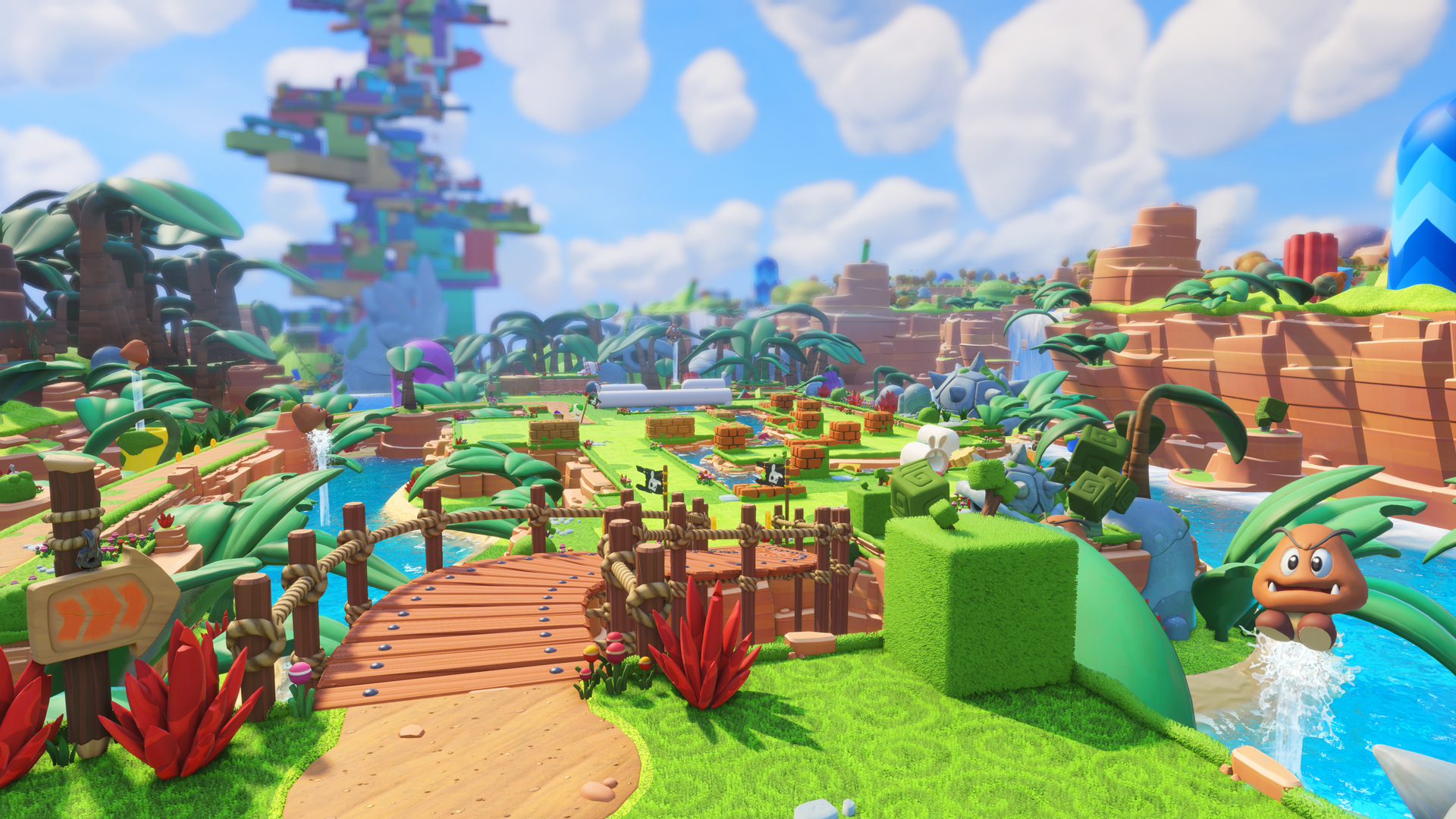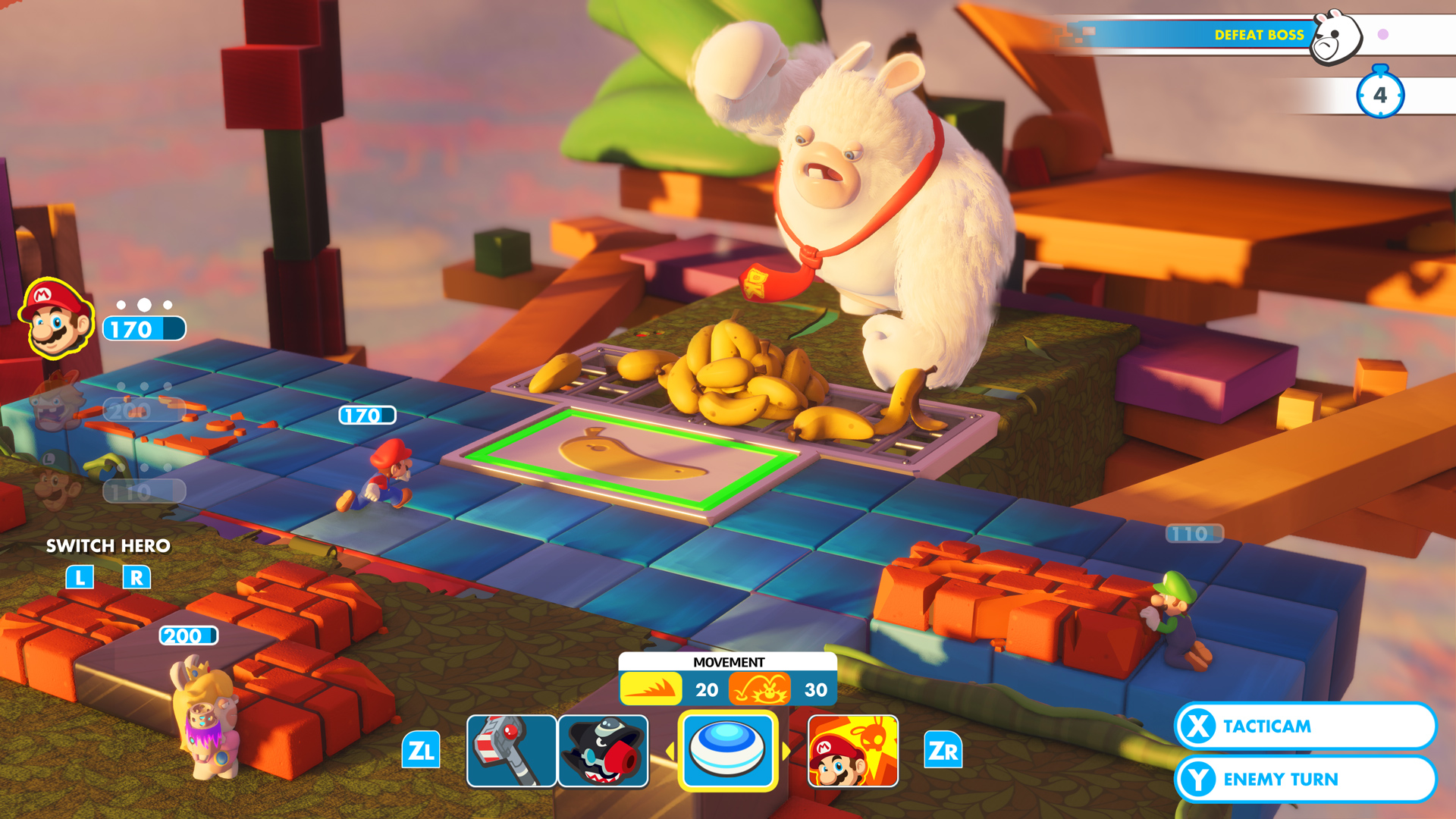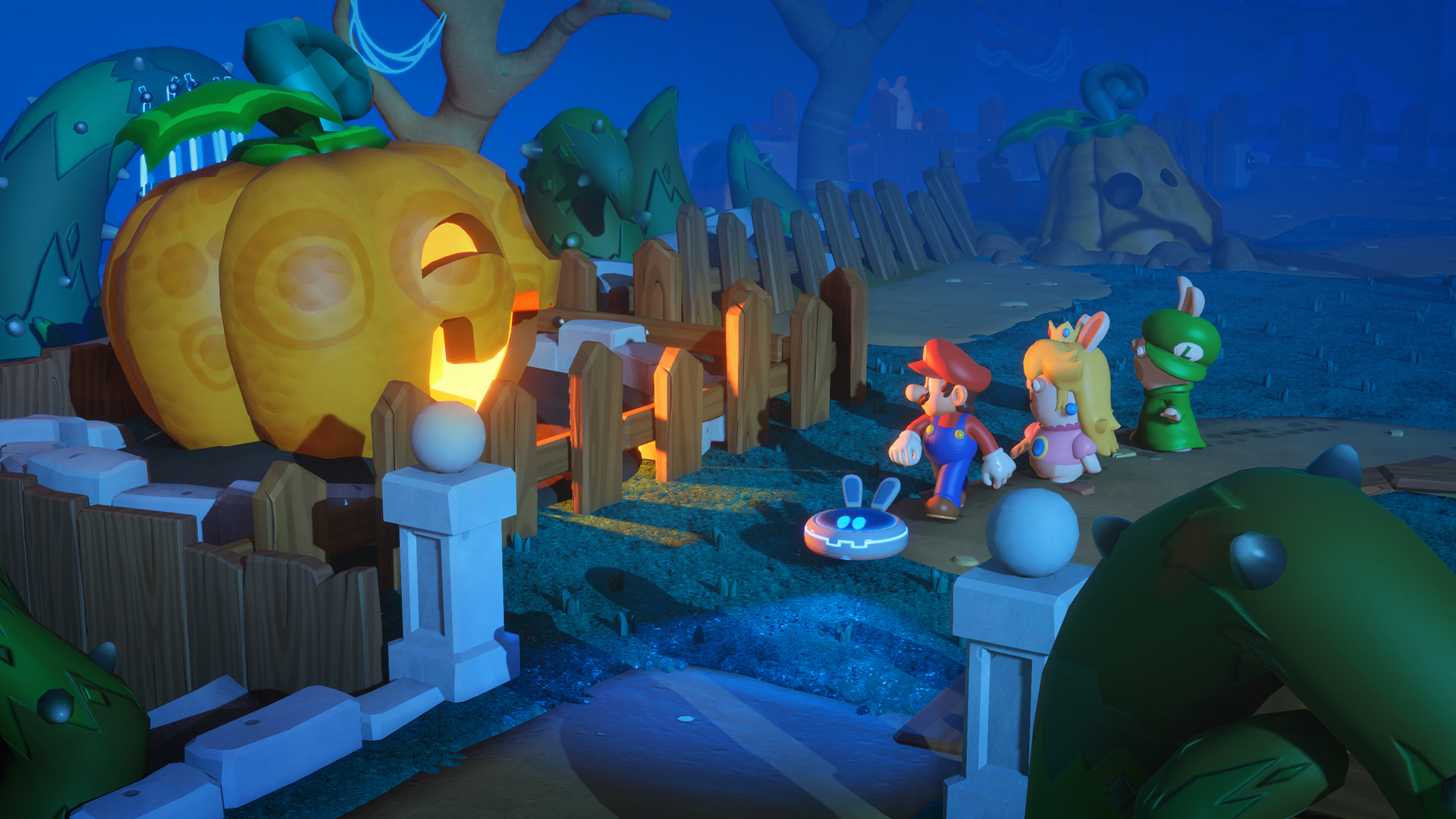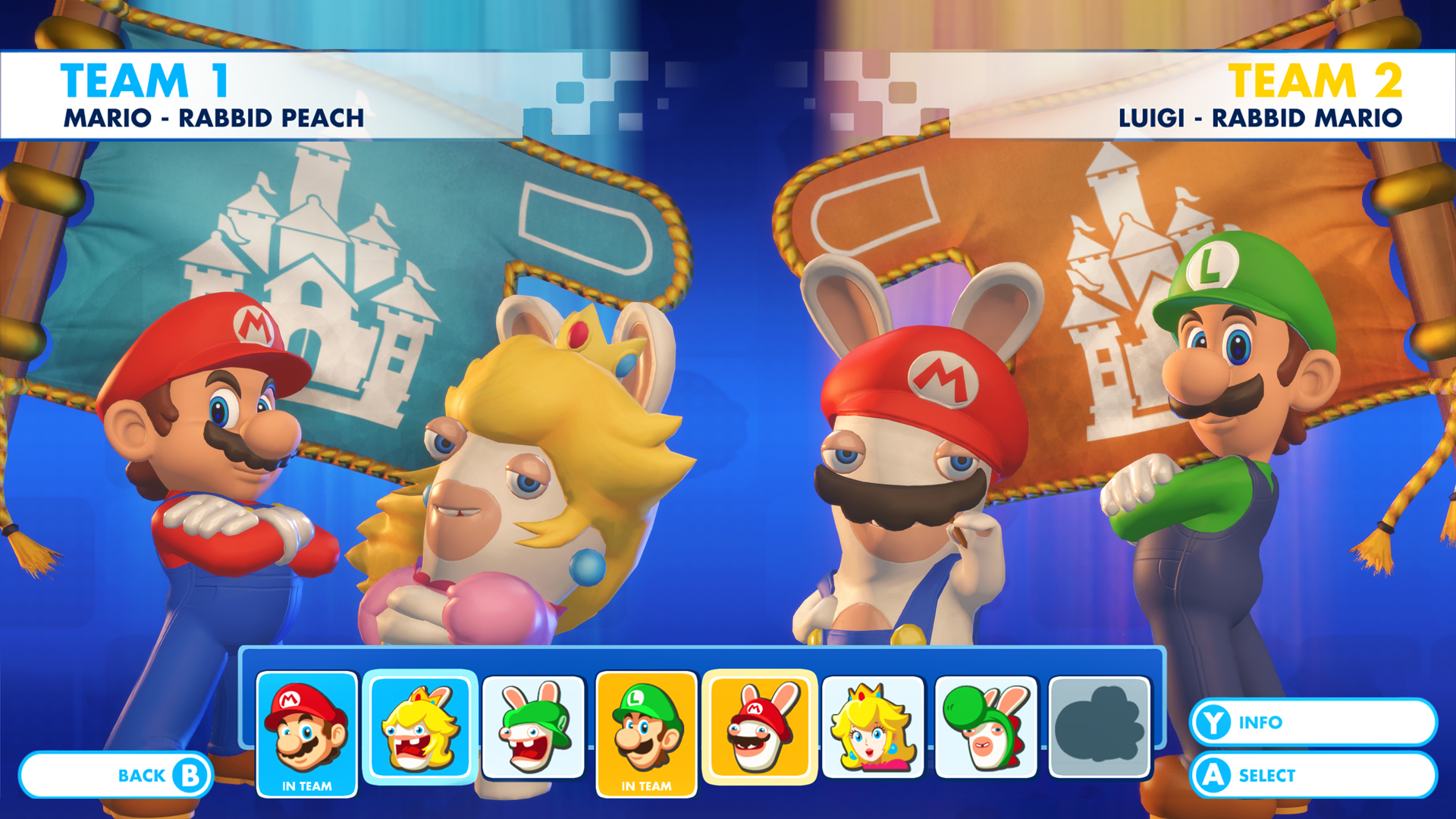The audacity of Ubisoft’s Mario + Rabbids Kingdom Battle for the Nintendo Switch is to transform Nintendo’s most cherished characters into tactical weapons slowed to the gait of chess pieces. It shouldn’t work, yet somehow does.
As if Nintendo’s classic characters couldn’t get any weirder, here is Super Mario hefting a futuristic blaster, with all his plump, plumberly pep distilled to numerics like “area of movement,” “dash” or “cleansing stomp.” He’s joined by brother Luigi, whose steely gaze guides stinging sniper shots over swathes of quirky terrain. Deranged bunny allies (the “Rabbids” from Ubisoft’s goofy Rayman-verse) cosplay the famous siblings and other familiar faces, capering across Skittles-bright battlefields like psychotic toddlers. Together they tail a hovering, hockey-puckish robot, dubbed “Beep-o,” who periodically interrupts to ground the game’s rollicking plot.

The conceit is that Nintendo’s Mario-verse and Ubisoft’s topsy-turvy Rabbids have catastrophically collided thanks to a child-brainiac’s augmented reality contraption that can merge objects. The Rabbids show up in a time-traveling washing machine, the helmet accidentally gloms onto one of the bunch, who kicks off a rash of transmogrifications, hybridizing characters and beloved landscapes before buddying with the usual Mario villains. It’s the stuff art team dreams are made of.
Mario’s already bizarre Mushroom Kingdom bursts with Rayman-ish peculiarities, like geysering toilets, grooving flowers and ivory pipes with bunny ears and lolling tongues. Zebra-striped treetops share turf with others that sport surreal curlicues. Snow and sand bleed together forming paradoxical biomes. Toy blocks frame a multihued jungle-gym commandeered by a hilarious alternate version of an iconic Nintendo adversary. It’s wacky, boisterous and absolutely gorgeous.

To reverse this Franken-tangling, players guide a preselected trio through these adorably absurd vistas, led in all cases by Mario, but with swappable spots for Luigi, Princess Peach, Yoshi or their loony Rabbids analogues. Levels (10 per each of the game’s four worlds) subdivide into zones, each freely explorable and stuffed with trip-the-switch traversal puzzles, secret areas and hidden collectibles you can inspect in the vicinity of Princess Peach’s castle, the game’s safe zone hub. (Completionists can also revisit and replay levels here.)
To make headway, Mario and pals must win past chessboard-like chokepoints folded into “chapters.” Venture into these and the game shifts to combat that plays out on grids and by turns, pitting scrums of mutant Rabbids against Mario and posse. Heroes and enemies wield short or long range weapons, each with collateral effects that can burn, blind, freeze and even knock combatants off the board. New and stronger enemy types shuffle onstage as the game unfolds, ratcheting up the difficulty and thereby the demands of resource allocation, which is what strategy games like this are really about.

Should Mario deploy a Mega Man-ish arm blaster to pick off a distant foe, or swing a Mario Bros. style hammer to pummel a nearby one? Perform a “dash” to dropkick an enemy, or “team jump” off a comrade to increase his maximum range? Hang back in cover, or risk taking enemy fire to slip into a pipe that’ll whisk him to high ground? Should Rabbid Peach fire a midrange cannon capable of gluing enemies in place, or dispatch a wheeled bomb that homes in on its target? Conjure a defensive forcefield, or revitalize nearby allies with a burst of healing energy? Jump on an ally to “cleanse” a status ailment or “double dash” to knock down a pair of opponents? Should two heroes activate “react” abilities, while the third lures enemies into a trap that triggers a devastating combo?
Choices like those inhabit countless precursor games, none more famous than Mythos and MicroProse’s 1994 category pacesetter X-COM: UFO Defense. A lot of what makes Mario + Rabbids feel idiosyncratic comes down less to tactical novelty than Ubisoft equaling and at times surpassing first-party Nintendo levels of veritably supernatural charm. Hypnosis-by-style is partly what’s going on here, in other words.

But it’s not everything. The game has a deceptively breezy flow that’s even smarter than studio Firaxis’s recent XCOM rethinks. This is “you go, I go” for the cinematic, over-the-top action crowd, the pause of a turn just a chance to tee up the next zany acrobatic spectacle. The game’s nod to multiplayer, a local cooperative mode that lets a pair of players guide allied teams of two with the Joy-Cons pulled off the Switch and held sideways, illustrates how friendly its learning curve is. My 5-year-old could eke out wins in the first of the game’s four cooperative campaigns after just one match with me coaching.
It’s almost too easy early on: once you’ve sussed a match’s particulars, winning is a fait accompli. That changes as you fight mid-bosses, then some pretty crazy end bosses. And the difficulty soars by the time you reach the second world’s midpoint. Keep going and you’ll really feel the vise turn, circumscribed by variables like turn limits (there’s a maximum number per battle) and incremental cash incentives (spendable on new weapons) for teams that can soldier through a set of clashes intact.

Win states eventually change, adding variety to matches otherwise about clearing the board. Some courses have literal end zones you simply have to touch to win. Others are escort sprints where you have to guide a vulnerable ally through enfilade fire. Special abilities allow teammates to zip around the map or heal each other, and “power orbs” acquired by winning battles or snatched from chests let you unlock new skills. Study up and these make it possible to execute ferocious multi-character combos.
Ubisoft offsets the sometimes daunting intricacy of team interaction by simplifying targeting rules: enemies are either out of range, half-obscured or fully exposed, offering zero, 50-50 or 100% odds of being struck. It’s a slick inversion of conventional turn-based tactics that keeps you moving and focused on maneuvering without getting bogged down in abstraction.

A word about BAFTA-winning composer Grant Kirkhope’s score. He’s pulled off something with understated elegance here, reimagining quaint Mario series tunes as counterintuitively contemplative orchestral pastiches with Jerry Goldsmith-esque twists and flourishes. You can collect bits of the soundtrack in-game or get it with the (totally sold out) $99 collector’s edition, but it deserves a standalone release as soon as possible.
As for the game, it’s a fan service fractal that works both as a gonzo strategy masterpiece and series love letter. It’s a studio-publisher (Ubisoft) that’s been around nearly as long as Nintendo’s been making video games, reflecting all the whimsy and allure of a franchise that’s sold half a billion copies worldwide. I blaspheme, but if you’ve ever wondered what an archetypal Nintendo game made not-by-Nintendo would look like, here you go.
5 out of 5
Reviewed on Nintendo Switch
More Must-Reads from TIME
- Why Trump’s Message Worked on Latino Men
- What Trump’s Win Could Mean for Housing
- The 100 Must-Read Books of 2024
- Sleep Doctors Share the 1 Tip That’s Changed Their Lives
- Column: Let’s Bring Back Romance
- What It’s Like to Have Long COVID As a Kid
- FX’s Say Nothing Is the Must-Watch Political Thriller of 2024
- Merle Bombardieri Is Helping People Make the Baby Decision
Write to Matt Peckham at matt.peckham@time.com